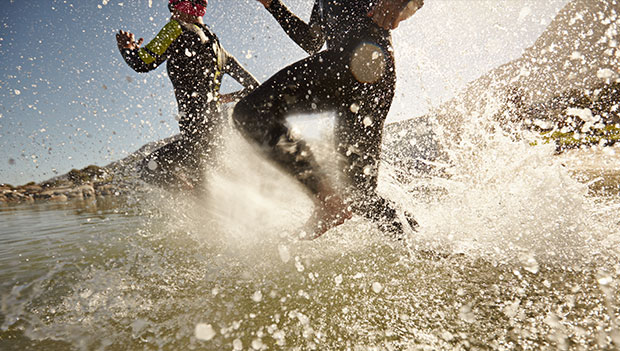
Triathlon is a demanding and exhilarating multi-sport event that combines swimming, cycling, and running. Whether you're a seasoned triathlete or just dipping your toes into this challenging world, understanding the specialized vocabulary of triathlon is essential for successful training and competition. In this comprehensive guide, we will unravel the complex language of triathlon by presenting 24 essential triathlon terms along with their precise definitions. By the end of this article, you'll be well-prepared to navigate the world of triathlon with confidence, knowledge, and enthusiasm.
Triathlon Terms & Definitions:
1. Transition (T1 and T2): Transition refers to the area in a triathlon where athletes switch between disciplines. T1 is the transition from swim to bike, and T2 is the transition from bike to run.
2. Drafting: Drafting in triathlon occurs when a cyclist follows closely behind another competitor to reduce wind resistance. Drafting is allowed in some races but prohibited in others.
3. Wetsuit Legal: Wetsuit legal refers to races where competitors are allowed to wear wetsuits for the swim portion. The decision is based on water temperature and safety considerations.
4. Open Water Swim: An open water swim is the swim portion of a triathlon that takes place in a natural body of water, such as a lake or ocean, as opposed to a pool swim.
5. Brick Workout: A brick workout involves training two disciplines back-to-back, typically a bike ride followed immediately by a run. It helps triathletes adapt to the transition between biking and running.
6. Sighting: Sighting is the technique of lifting your head out of the water during an open water swim to ensure you're swimming in the right direction and avoiding obstacles.
7. Aero Bars: Aero bars are handlebar extensions on a triathlon bike that allow athletes to assume a more aerodynamic position.
8. Tri Suit: A tri suit is a one-piece or two-piece garment designed for triathletes, providing comfort and convenience during all three disciplines.
9. Chip Timing: Chip timing uses electronic chips attached to athletes' ankles or bibs to record their exact race times, ensuring accuracy in large events.
10. Transition Bag: A transition bag is a bag used to organize and transport gear for both T1 and T2. It helps athletes quickly access what they need during transitions.
11. Taper: Tapering is the process of reducing training volume and intensity in the weeks leading up to a race to ensure athletes are rested and in peak condition on race day.
12. Triathlon Bike: A triathlon bike, or "tri bike," is a specialized bicycle designed for triathlons, featuring aerodynamic components and geometry.
13. Race Belt: A race belt is an adjustable belt that holds an athlete's race number, allowing them to easily switch it from the swim to the bike and run.
14. Chute: The chute is the designated area where athletes exit the swim and enter the transition area during a race.
15. Aid Station: Aid stations are stations along the run course of a triathlon where athletes can grab water, energy gels, or other supplies.
16. Age Group: In triathlon, participants are often grouped by age for competition, allowing athletes to compete against others in their age category.
17. DNF (Did Not Finish): DNF is an abbreviation used to indicate that an athlete did not complete the race.
18. Clipless Pedals: Clipless pedals are pedals that attach to special cycling shoes, providing a secure connection between the foot and the pedal.
19. Bonk: "Bonk" refers to a sudden and severe depletion of energy and glycogen during a race, resulting in fatigue and impaired performance.
20. Triathlon Coach: A triathlon coach is a trained professional who helps athletes develop training plans, improve performance, and reach their triathlon goals.
21. Aquabike: An aquabike is a multi-sport race that combines swimming and cycling but excludes the running portion, making it suitable for athletes with injuries or limitations.
22. Race Director: The race director is responsible for organizing and overseeing the logistics of a triathlon event, ensuring it runs smoothly and safely.
23. Transition Area: The transition area is a designated space within the race venue where athletes set up their gear for the transitions between disciplines.
24. IM (Ironman): Ironman is a brand of long-distance triathlon races known for their challenging 2.4-mile swim, 112-mile bike ride, and 26.2-mile run.
Conclusion:
Triathlon is more than just a race; it's a multi-sport adventure that demands a combination of physical prowess, mental fortitude, and technical knowledge. By immersing yourself in these 25 essential triathlon terms and their corresponding definitions, you gain the language and proficiency to navigate the world of triathlon confidently. Armed with this knowledge, you can communicate effectively within the triathlon community, make informed decisions about your gear and training, and ultimately embark on your triathlon journey with a deeper understanding and appreciation for the sport. So, whether you're a seasoned triathlete or a first-timer, dive into the triathlon lexicon, conquer the transitions, and race towards your goals with confidence, competence, and unwavering enthusiasm for the world of triathlon.
By clicking on the product links in this article, we may receive a commission fee at no cost to you, the reader. Sponsorships and affiliate commissions help support our research so we can help you find the best products. Read full affiliate disclosure here.
Why Trust Us?
ACTIVE.com's editorial team relies on the knowledge and experience of fitness and wellness experts including competitive athletes, coaches, physical therapists, nutritionists, and certified trainers. This helps us ensure the products we feature are of the highest standard. Collectively, the team has spent countless hours researching equipment, gear, and recovery tools in order to create the most accurate, authentic content for our readers. Customer satisfaction is also a key part of our review process, which is why we only feature products that are highly rated.

